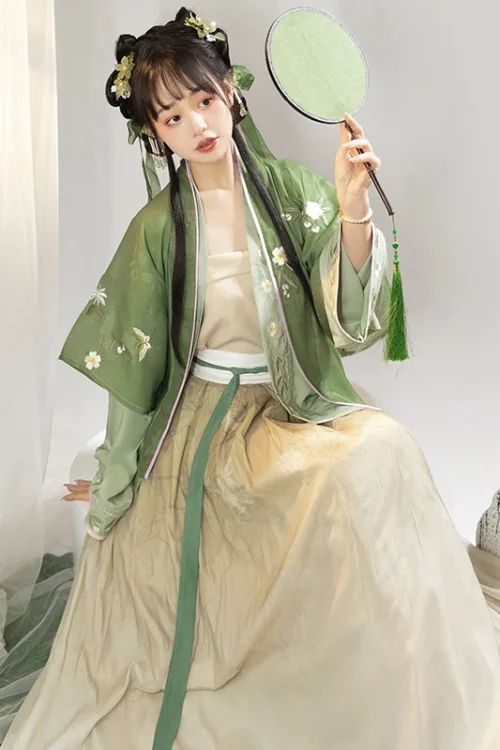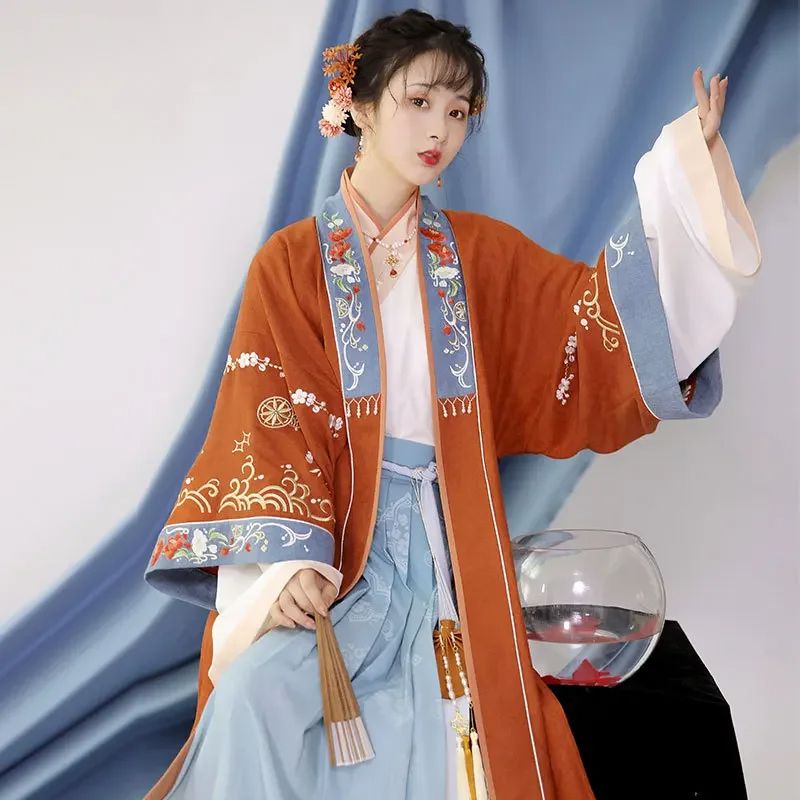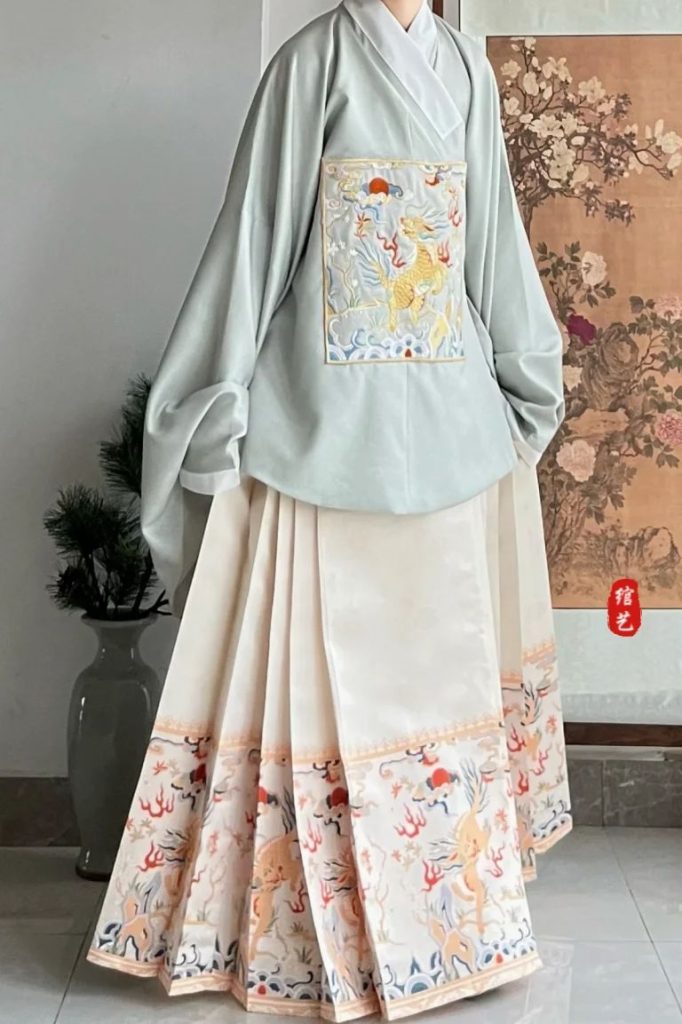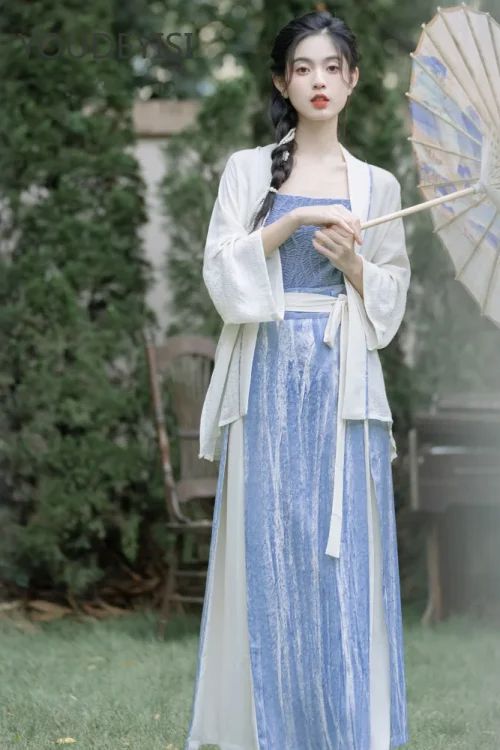The Evolution of the Bat Pattern in Hanfu
The bat pattern, a ubiquitous motif in Chinese culture, holds a prominent place in the intricate tapestry of Hanfu, the traditional attire of the Han Chinese. Its origins can be traced back to ancient times, where bats were revered as symbols of good fortune and longevity.

Origins in the Han Dynasty
During the Han dynasty (206 BCE – 220 CE), the bat pattern began to appear on Hanfu as a decorative element. Initially, it was primarily used on the sleeves and hems of garments, often in conjunction with other auspicious symbols such as clouds and dragons. As the Han dynasty progressed, the bat pattern gained popularity and became more elaborate, with variations in its shape and design.

Zenith in the Dinastía Tang
In the Tang dynasty (618 – 907 CE), the bat pattern reached its zenith of popularity. It was incorporated into a wide range of Hanfu garments, from formal court robes to everyday attire. The Tang dynasty also saw the emergence of the “five bat pattern,” which featured five bats arranged in a symmetrical design. This pattern symbolized the “five blessings” of longevity, wealth, health, virtue, and a peaceful death.
Decline and Resurgence in Later Dynasties
Durante el Dinastía Song (960 – 1279 CE), the bat pattern continued to be widely used on Hanfu, but its popularity gradually declined. It was primarily employed on ceremonial garments and auspicious occasions. The Dinastía Ming (1368 – 1644 CE) witnessed a resurgence of interest in the bat pattern, which was often combined with other motifs such as flowers and birds.


In the Qing dynasty (1644 – 1912 CE), the bat pattern experienced a decline in popularity once more. However, it remained an important element in the costumes of certain ethnic minorities, such as the Manchus and Mongols.
Moderno Interpretaciones
Today, the bat pattern continues to be used in modern Hanfu designs, albeit to a lesser extent than in the past. It is often incorporated into garments as a subtle nod to tradition and as a symbol of good fortune. The evolution of the bat pattern on Hanfu reflects the changing tastes and cultural influences that have shaped Chinese fashion throughout history. From its humble beginnings as a decorative element to its status as a symbol of auspiciousness, the bat pattern has left an enduring mark on the rich tapestry of Hanfu.

Symbolism and Meaning of the Bat Pattern in Hanfu
The bat pattern, a ubiquitous motif in Hanfu, the traditional clothing of the Han Chinese, holds profound cultural and symbolic significance. Its origins can be traced back to ancient Chinese mythology, where bats were revered as auspicious creatures associated with good fortune, longevity, and prosperity.
Phonetic Significance
The Chinese character for “bat” (蝠) is a homophone for the word “fu” (福), which means “blessing” or “good fortune.” This phonetic association further reinforced the bat’s auspicious connotations. As a result, the bat pattern became a popular decorative element on Hanfu, symbolizing the wearer’s desire for happiness and well-being.
Variations of the Bat Pattern
The bat pattern was often depicted in various forms and styles. One common variation was the “five-bat pattern,” which featured five bats arranged in a symmetrical design. The number five held special significance in Chinese culture, representing the five elements (wood, fire, earth, metal, and water) and the five cardinal directions. The five-bat pattern thus symbolized harmony, balance, and the protection of the wearer from all sides.
Another popular variation was the “double-bat pattern,” which depicted two bats facing each other. This design represented the concept of “double happiness,” a wish for good fortune in both personal and marital life. The double-bat pattern was often used on wedding garments and other auspicious occasions.
Cultural Presence
The bat pattern was not only confined to clothing but also found its way into other aspects of Chinese culture. It was commonly used in architecture, ceramics, and other decorative arts. The presence of the bat pattern in these contexts further emphasized its auspicious and protective qualities.
Conclusión
In conclusion, the bat pattern on Hanfu is a testament to the rich symbolism and cultural significance embedded within Chinese traditional clothing. Its association with good fortune, longevity, and prosperity made it a highly sought-after motif, adorning the garments of those who wished to attract blessings and ward off misfortune. The bat pattern continues to be a cherished element of Hanfu today, serving as a reminder of the enduring cultural traditions and beliefs of the Han Chinese people.
Variations and Styles of the Bat Pattern in Hanfu
The bat pattern, a ubiquitous motif in Chinese culture, holds a prominent place in the intricate designs adorning Hanfu, the traditional clothing of the Han Chinese. This auspicious symbol, often depicted in pairs, represents good fortune, happiness, and longevity.
Historical Presence
The bat pattern’s presence in Hanfu can be traced back to ancient times, where it was believed to possess protective powers. Over the centuries, it has evolved into a diverse array of variations, each with its own unique characteristics.
Common Variations
One of the most common types of bat patterns is the “flying bat,” which depicts the animal in flight. These bats are typically rendered in a stylized manner, with their wings outstretched and their bodies elongated. They may be depicted in various orientations, such as facing each other or flying in opposite directions.
Another popular variation is the “cloud bat,” which incorporates cloud motifs into the design. These bats are often depicted with their wings resembling clouds, creating a sense of ethereal beauty. The cloud bat pattern symbolizes good fortune and prosperity, as clouds are associated with rain and abundance.
The “double bat” pattern, as its name suggests, features two bats facing each other. This design represents harmony, unity, and the concept of yin and yang. It is often used in wedding attire and other auspicious occasions.
Interpretaciones contemporáneas
In addition to these traditional variations, there are also more contemporary interpretations of the bat pattern. Some designers have incorporated modern elements into their designs, such as geometric shapes and abstract patterns. These innovative approaches breathe new life into the ancient motif while still preserving its cultural significance.
Conclusión
The bat pattern is not only a decorative element in Hanfu but also carries deep cultural and symbolic meaning. It represents the Chinese people’s hopes for good fortune, happiness, and a long and prosperous life. As Hanfu continues to gain popularity both within China and abroad, the bat pattern remains an enduring symbol of Chinese culture and tradition.
